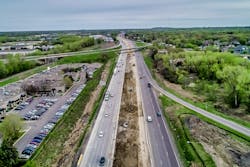NO. 9 ROAD: In the Name of Traffic Maintenance
Not even people who enjoy listening to podcasts and books on tape like sitting in traffic (though those things can make it easier).
In the northern suburbs of Blaine, Minnesota, the I-35W MnPASS project was launched to combat increasing traffic volume. To make sure motorists weren't stuck listening to their favorite forms of entertainment any longer than they have to, a 12.5 mile stretch from County Road C in Roseville to Lexington Avenue in Blaine added an express lane in each direction. The new pavement extended north to Sunset Avenue in Lino Lakes.
These weren’t the only improvements. In the northern Twin Cities suburbs five bridges were replaced, rehabilitating one bridge, and performing safety upgrades such as reconstructing crosswalks and sidewalks to comply with ADA standards. The project also included seven noise walls spanning four miles between highways and residential neighborhoods to mitigate noise, upgraded deteriorating roads with new pavement, restored sediment-laden ditches and culverts, and new ponds and drainage patterns.
Of course, this project didn’t come without its fair share of challenges. Traffic maintenance was seen to be one of the major challenges, with more than 100 lane-miles and 50 connecting ramps on the project. The Minnesota Department of Transportation (MnDOT) recognized that the project would require a complex maintenance of traffic. Traffic volumes, alternative routes, and construction sequencing all had to be considered when moving forward with the project. After a careful review of all of those areas, Ames Construction identified a staging approach and continued Maintenance of Traffic (MOT) design and construction efforts during pursuit phases. Additional design coordination refined the MOT approach and led to early constructibility reviews, and immediate design development once awarded.
The team had to come up with innovative construction techniques with already existing utilities and infrastructure in the area. One of the bridge locations was under power lines with limited shut down space, so Ames adjusted the abutment design and used low-clearing pile driving equipment to safely work under the active lines. One bridge location had two 60-inch water mains directly behind the in-place abutment, close to where the proposed abutment wall was going to go. Ames had to design a temporary earth retention wall of pile and lagging that could be installed with alternative methods instead of conventional driving pile.
Safety is always a concern on these projects. Miles of portable precast concrete barriers (PPCB) were put throughout the projects corridor. The PPCB acted as a barrier between the workers and traffic. Another safety precaution involved inviting local emergency service dispatch and drivers to select planning and site meetings to review access locations in the event they would be required for construction workers’ calls or local response routes through the project.
They went one step further and ensured that the local community knew what was going on with the project. For every traffic adjustment, a notice was provided 14 days earlier and distributed to local stakeholders detailing the change, detour, alternative routes, and durations. Ames worked closely with MOT designers, MnDOT, and public outreach teams to efficiently distribute these notices. R&B
Project: I-35W North MnPASS
Location: Blaine, Minnesota
Owners: The Minnesota Department of Transportation
Designer: Alliant Engineering, Inc.
Contractor: Ames Construction
Cost: $208 million
Length: 12.5 miles
Completion Date: August 2021
